Big Trip, Aug 1: Indian to Ranchero
Apparently, if you sleep in a wigwam, you wake up as an Indian.
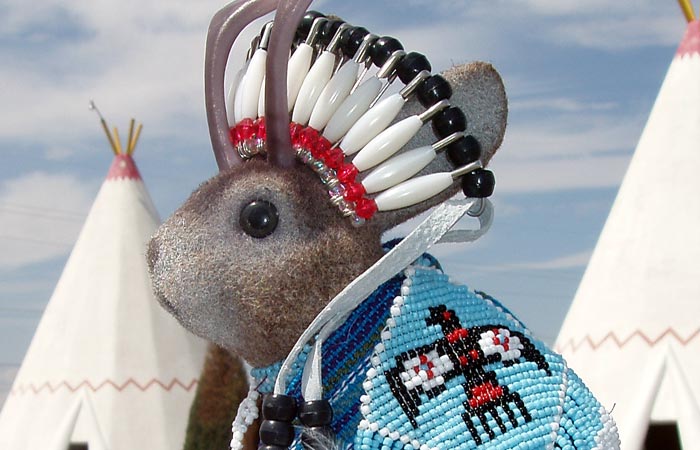
Jackalopes are, after all, Native American.
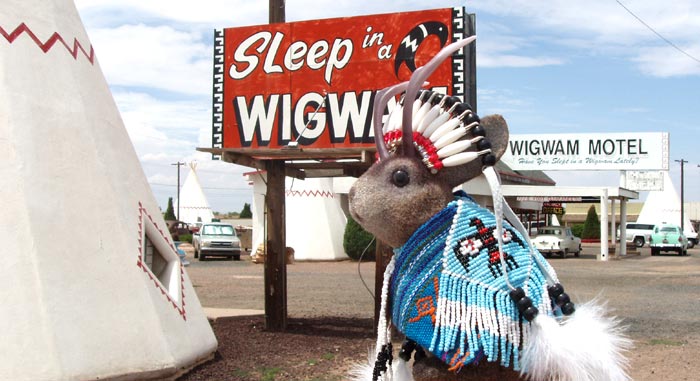
I doubt the concrete Brontosaurus was part of the original design, but it's in character with Holbrook, which has a few of them around.
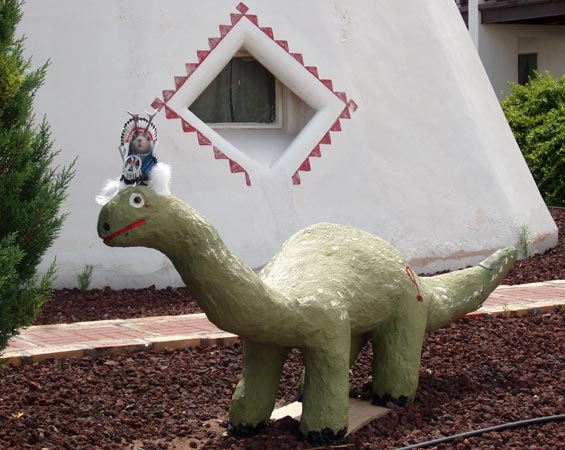
These things are beautiful, but I think I like them at night when you can't see the phone poles and such.
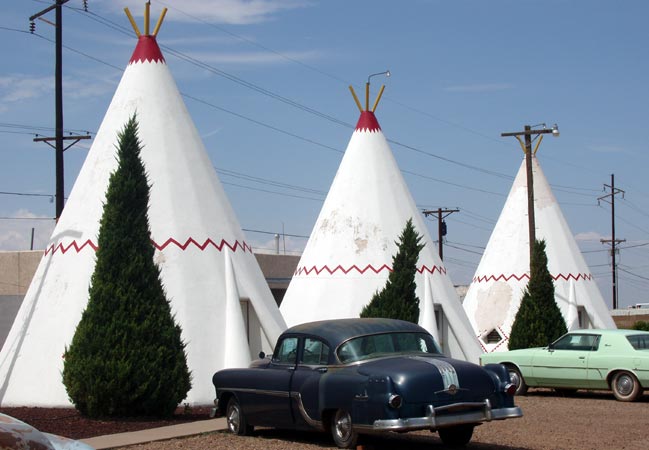
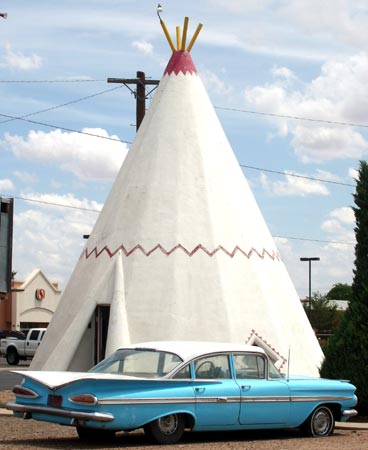
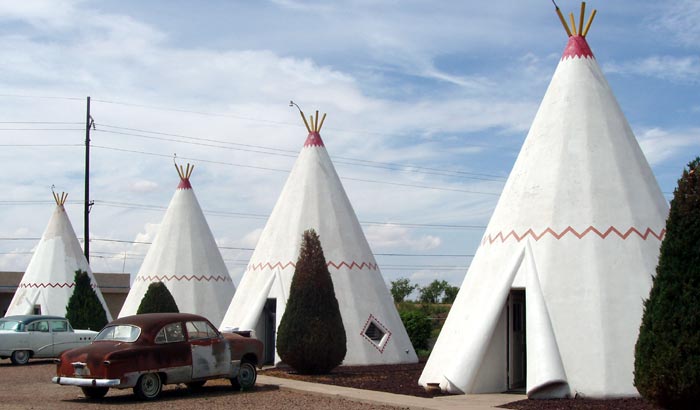
The motel turned out to be a good place to watch trains. The view directly South is blocked by another building, but the view is clear to the Southwest...
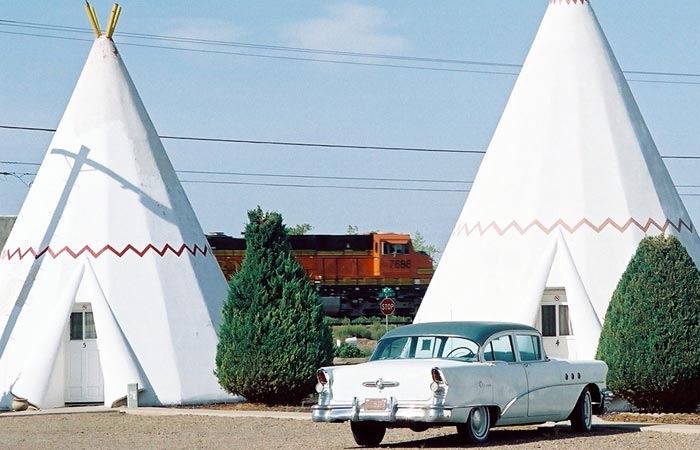
...as well as to the Southeast. The summer sun leaves the North sides of the trains in shadow by mid-morning. Winter would be a better time for this.
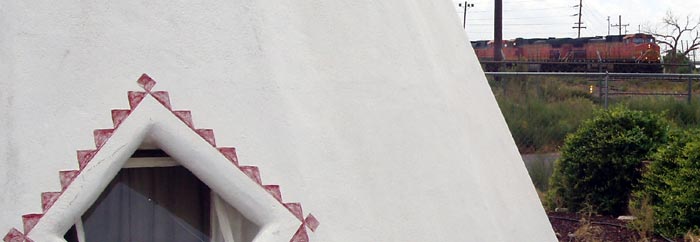
Ace is ready to resume his journey West, but first, if the wigwams look familiar to you but you've never seen them before, you may have seen the Cozy Cone Motel in the Disney/Pixar movie, "Cars."
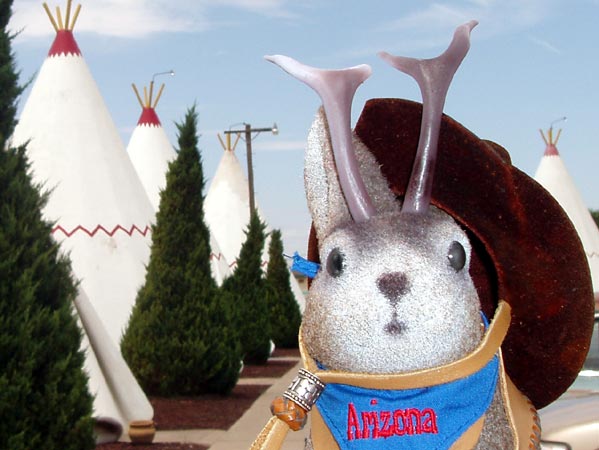
This sign for the Pow Wow rock shop in Holbrook hints that the shop might have been a motel in a previous life.
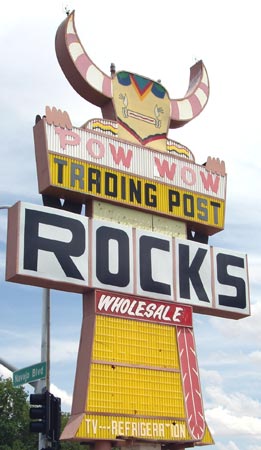
New Mexico isn't the only Southwest state to have nicely decorated bridges; this is Interstate 40 at Holbrook.
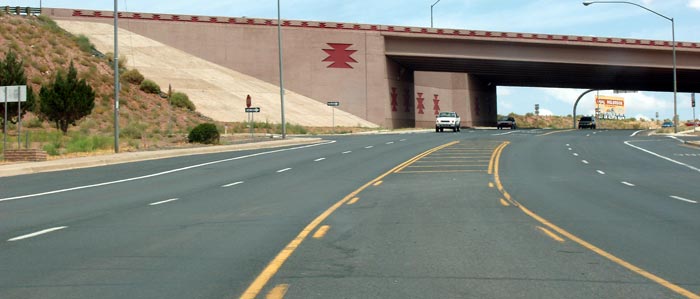
I've never stopped at the dinosaur park at exit 292, though I'd like to, someday. However, I'm not sure a blurred view of them from a car going 70mph doesn't gloss over some flaws and give them a bit more realism.
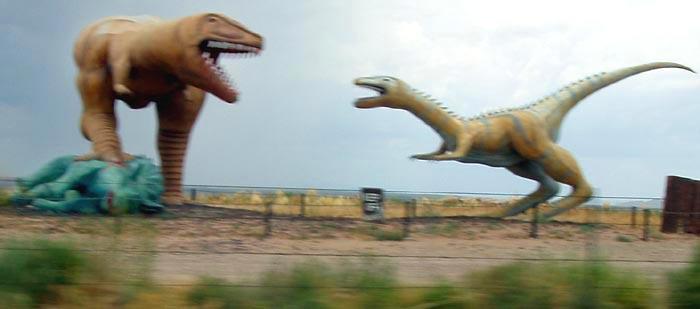
"Dust devils" are small tornado-like air vortexes that scoop up a lot of dust. If you look near the top of the picture, as well as at the ground, you can tell this one is quite tall.
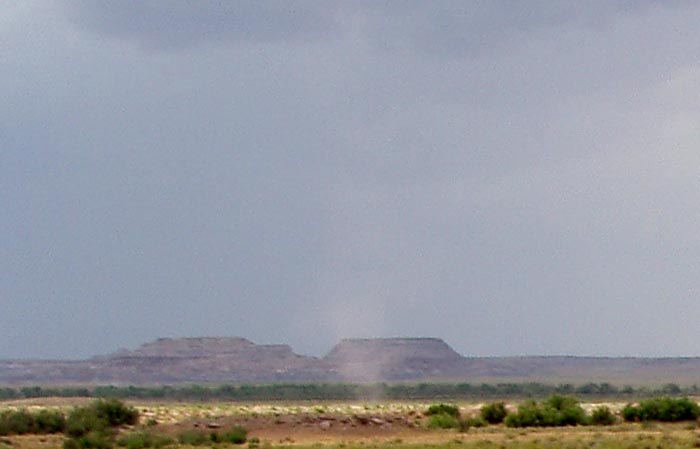
I'd not stopped in this tourist trap before. It's just West of the entrance to the Petrified Forest National Park.

Petrified wood, culled from private land around the park, is quite plentiful and cheap in it's raw form.
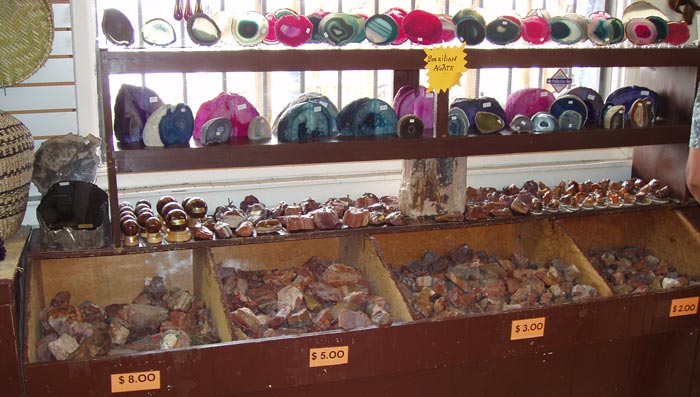
This sort of fake teepee is common at classic tourist traps in "indian country." Along Rt66/Hwy 40 in this part of Arizona, you can see them at Meteor City, and Geronimo's, in addition to these at the Painted Desert Indian Center. They are all so alike in structure that I wonder if the same person made them. This one features Kokopelli, the hunchback flute player so common in Southwest imagery...more about him when we reach the Painted Desert.
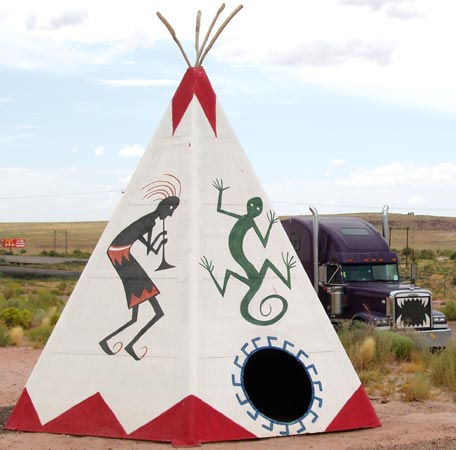
All day long, it seemed to be storming in the West.
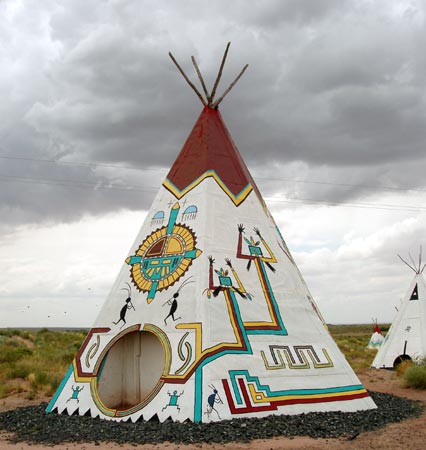
The indian boy painted on this one looks suspiciously like an early Santa Fe logo.
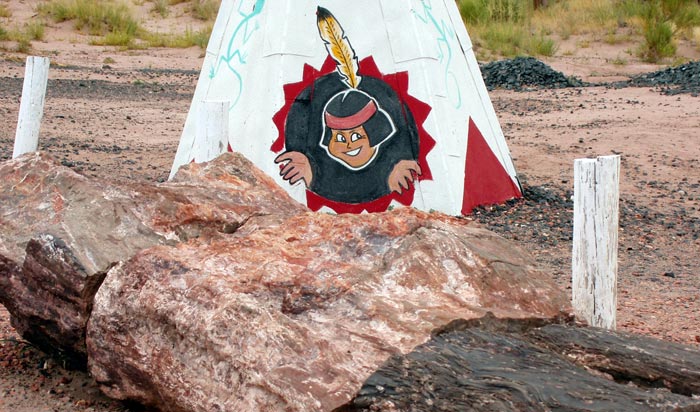
We finally reached our main target of the day, the Petrified Forest National Park.
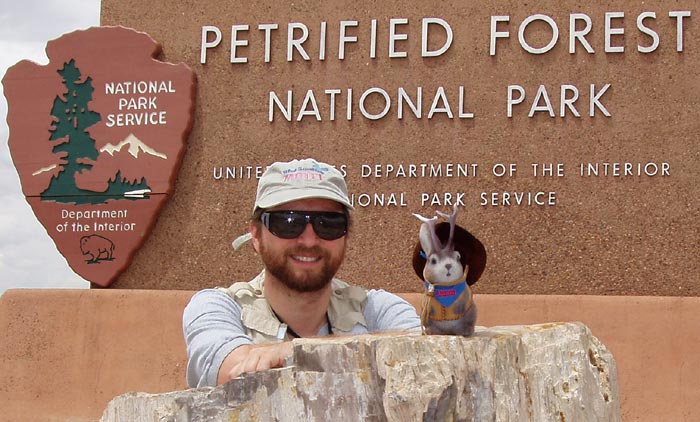
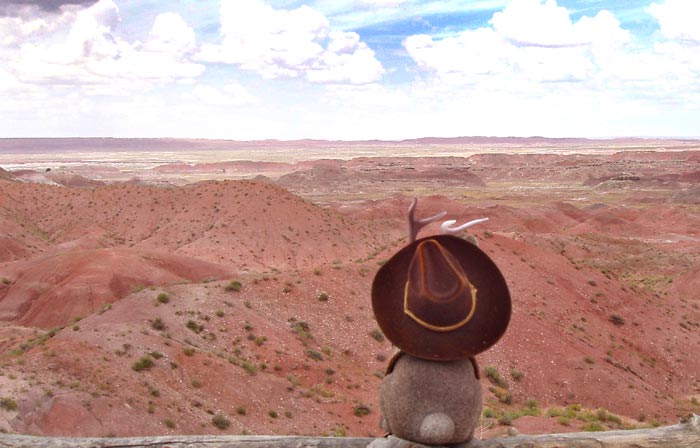
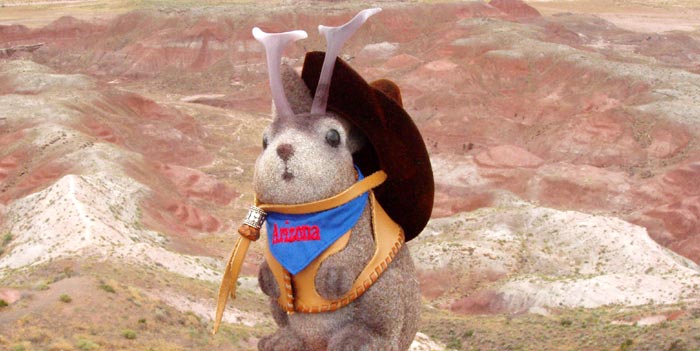
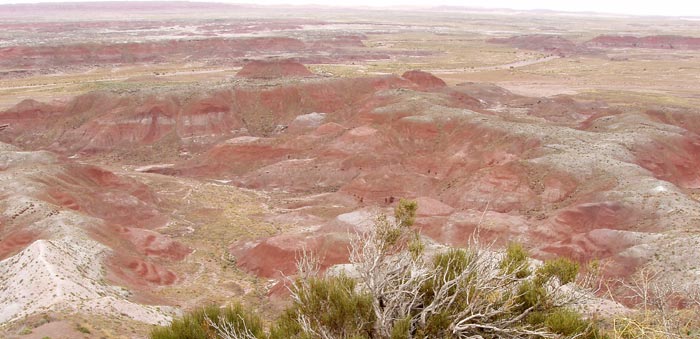
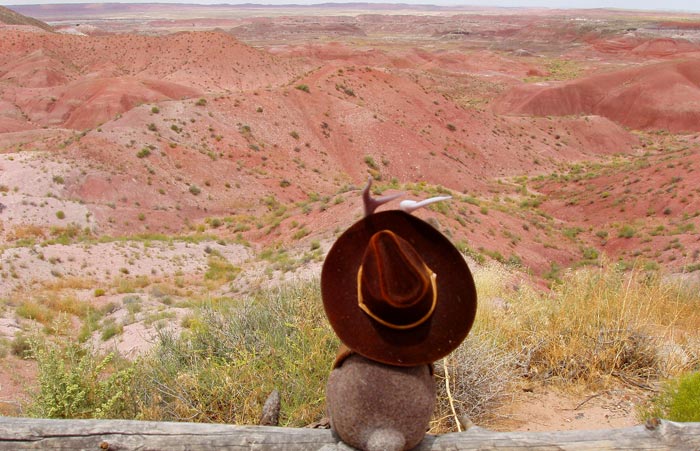
The Burlington Northern/Santa Fe main line runs through the park. About 60 trains a day pass through; the remains of Rt66 run alongside. The track was originally laid by The Atlantic and Pacific Railroad in 1882 and it was the catalyst for the founding of such towns as Holbrook and Winslow. Later, the track became part of the Santa Fe. The Fred Harvey Company, famous for its hotels along the Santa Fe, used to run tours through the Petrified Forest in the 1930's. Tourists would ride through this land in open roofed "Harvey cars."
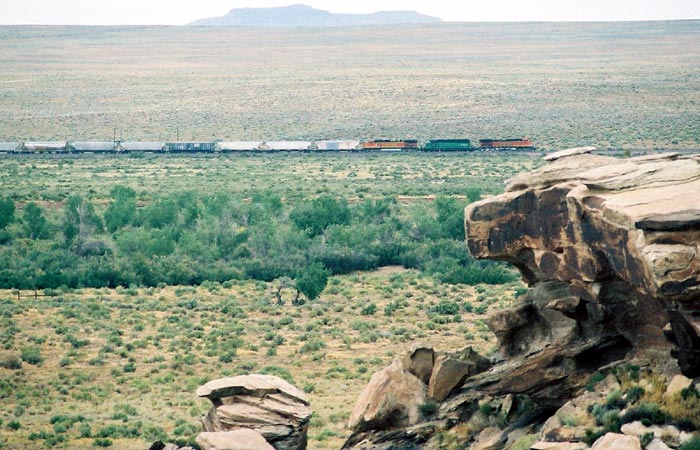
These are part of the remains of the Puerco Pueblo, which was inhabited between about A.D. 1250 to A.D. 1380. The pueblo had at least 100 rooms surrounding a central plaza. Artifacts found at the site indicate the inhabitants had contact with both the Mogollon/Zuni people of the mountains to the South and the Anasazi/Hopi people of the mesas and canyons to the north.
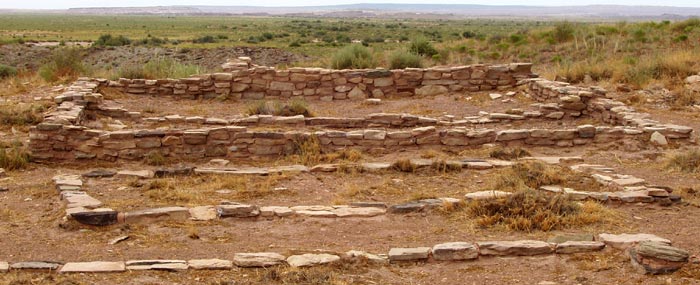
Raymond Redcorn, an intern from the Kansas City area, was on hand to explain the petroglyphs at the Puerco Pueblo site as well as another site called Newspaper Rock.
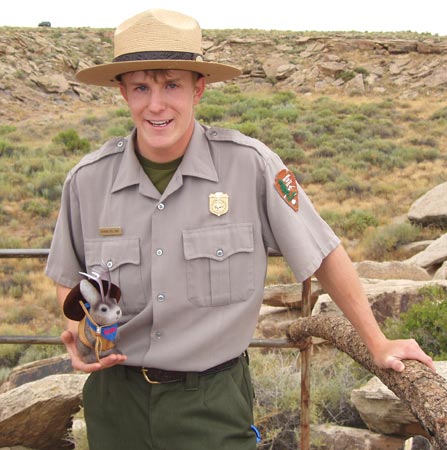
Petroglyphs are ancient symbols scratched into a thin patina that forms on rocks when they are exposed to the elements. The patina is called "desert varnish" and it's color is determined by the mineral content of the rock.
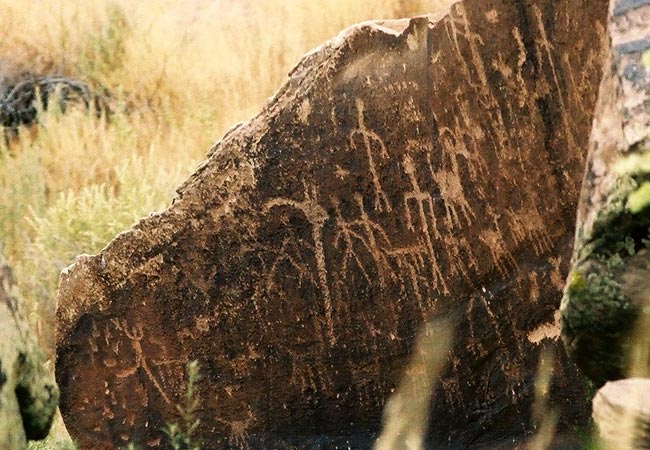
Blacker shades are higher in manganese oxides...
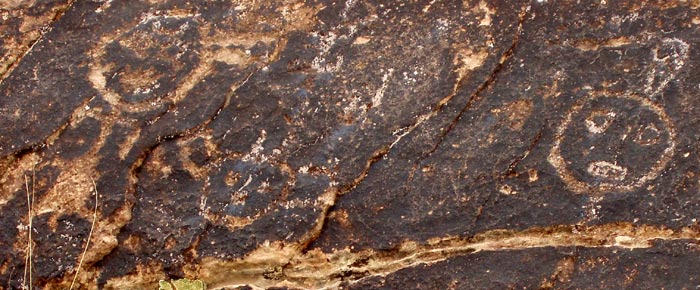
...while redder tones are caused by iron oxides.
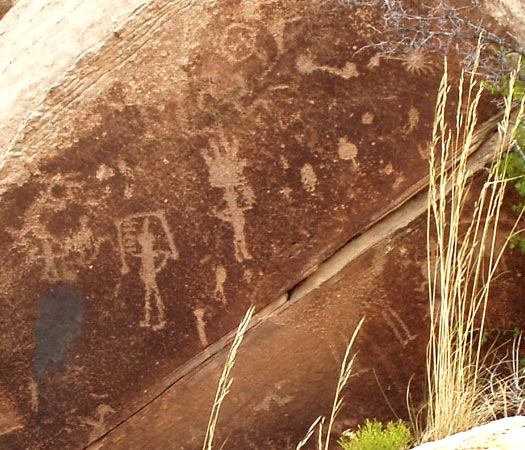
Newspaper Rock is a huge conglomeration of petroglyphs.
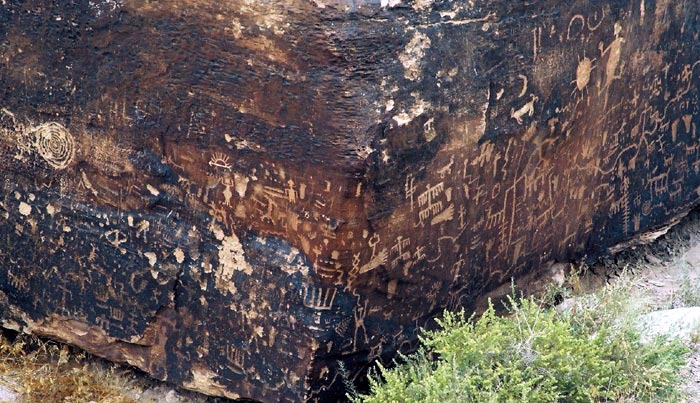
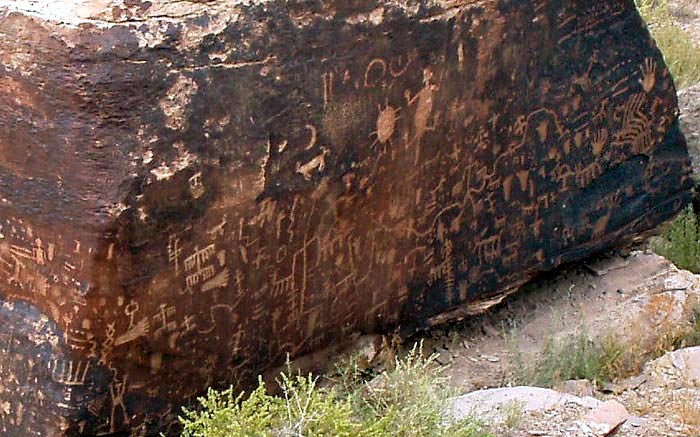
This set of rocks and petroglyphs near Puerco Pueblo is a solstice marker. The mid-summer sunrise would shine through the gap between the rocks at upper left...
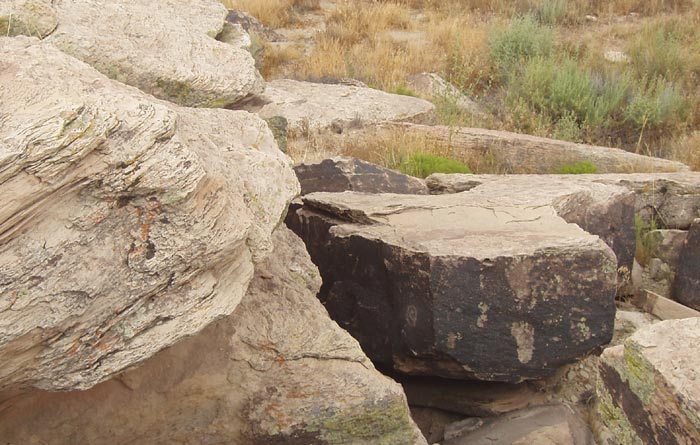
...and onto the spiral seen in the left third of this picture.
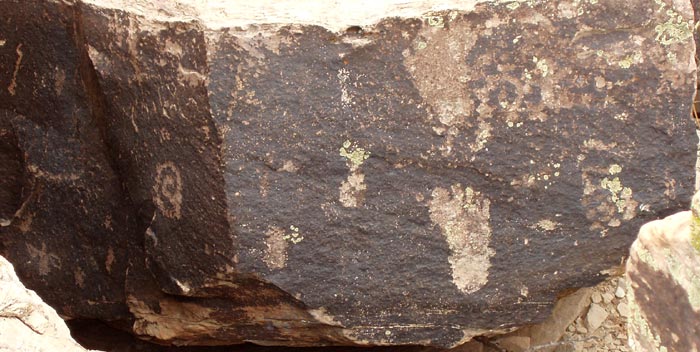
There is a variety of types of petroglyphs: anthropomorphs (human-like figures)...
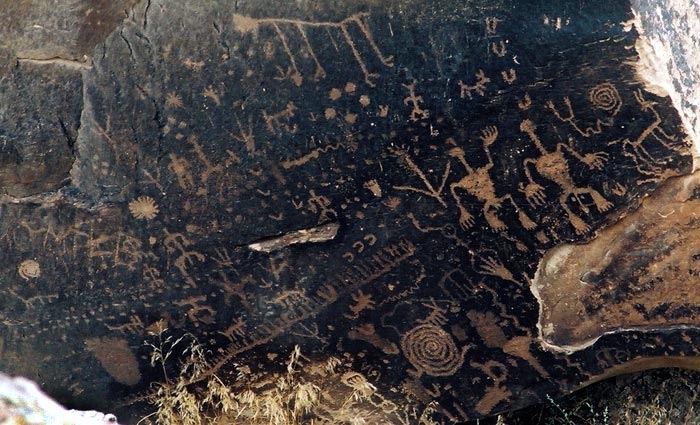
...zoomorphs (animal-like figures)...
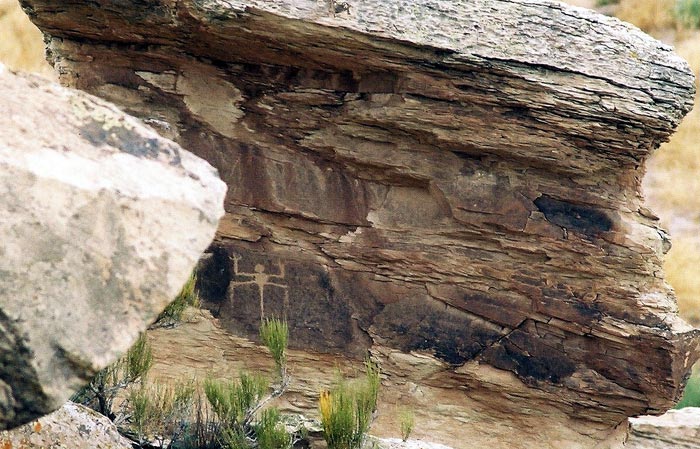
...katsinas (spiritual figures), hands, tracks and geometrics. This is a set of geometrics with an anthropomorph to the left and three zoomorphs in the middle.

Some of the petroglyphs are pretty hard to see at a distance.
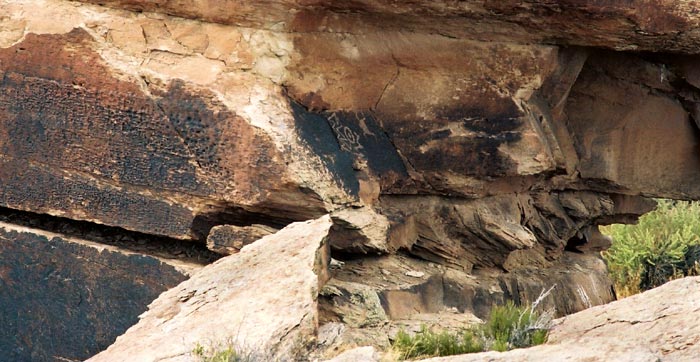
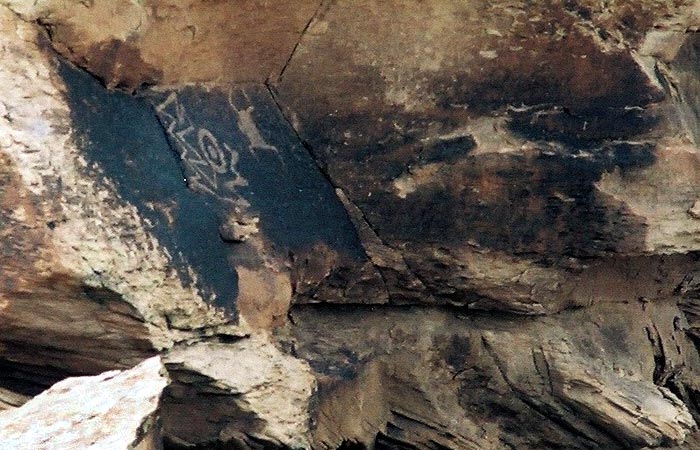
The petroglyphs in the park are thought to be 650 to 2000 years old.
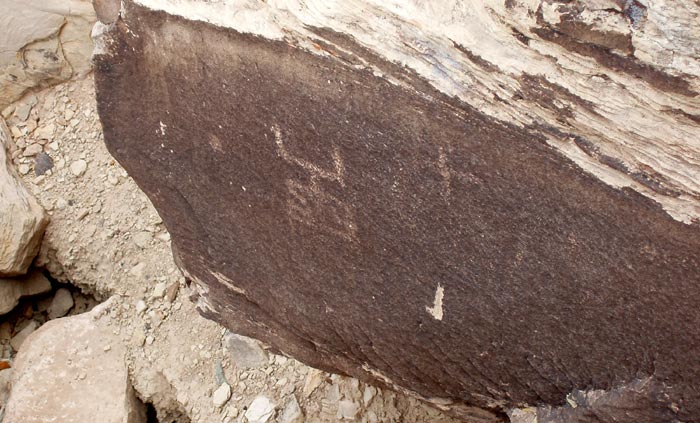
An isolated boulder near Newspaper Rock contains a petroglyph of Kokopelli, the hunchback flute player so common in Southwest imagery.
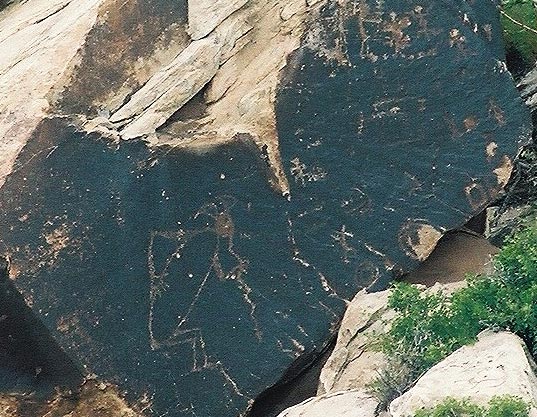
At least 13 variations of Kokopelli existed in ancient illustrations; some are insect-like and others, more human. He seems to have been popular enough to cross ancient cultural lines and there are variations on his tale, but all versions credit him with fertility of land and women.
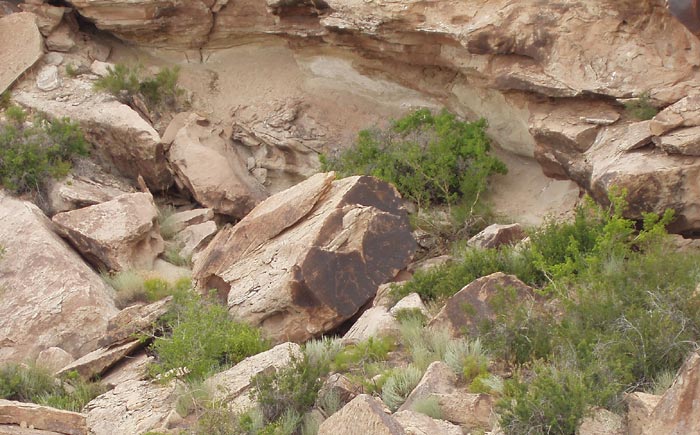
Kopopelli has become a much-exploited symbol of Native American culture and I've seen giant metal statues, brightly colored stuffed toys, key chains, coin purses, refrigerator magnets and the coaster Ace is wearing. You name it, if its a tourist trap item, he's there. I've seen him used on "local" souvenirs as far out of his range as Missouri and Mexico.
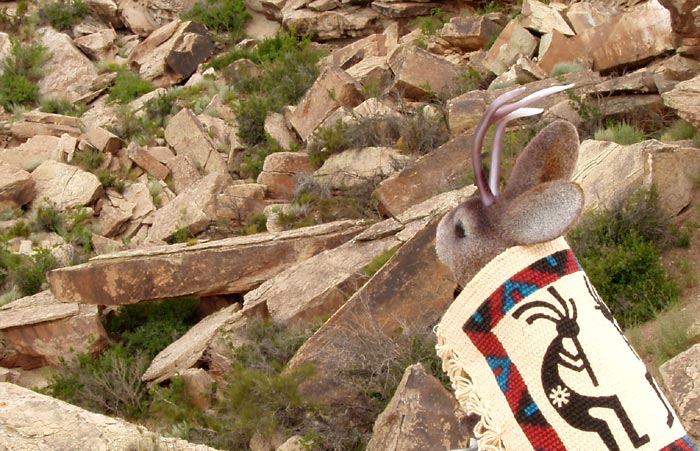
I think it's a nice touch that the doors to the restrooms at the Puerco Pueblo ruins feature these plexiglass petroglyph panels.
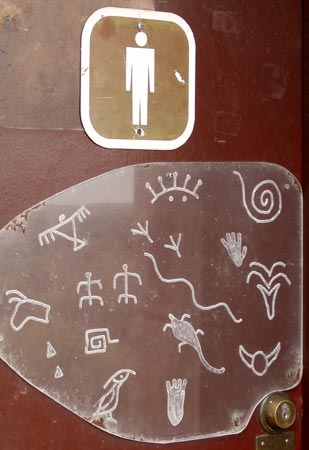
This petrified log has splintered into many thousands of pieces over the years.
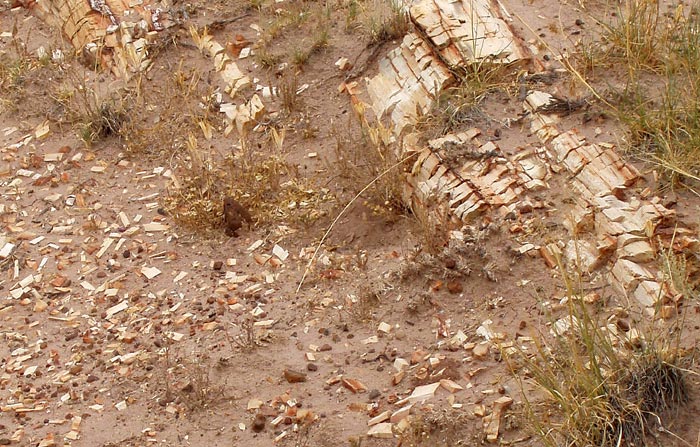
Even though the overcast weather dulled the colors, the landscape was worth a few stops.
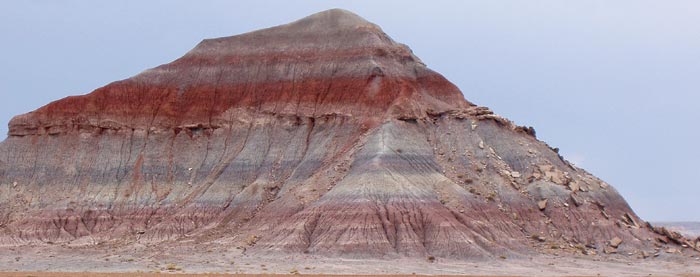
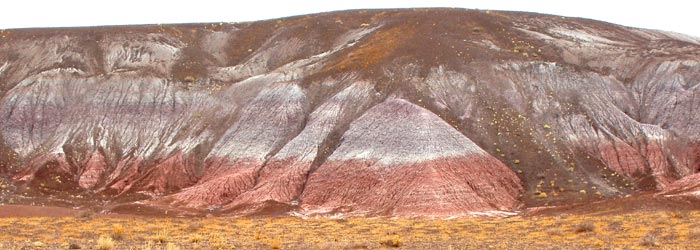

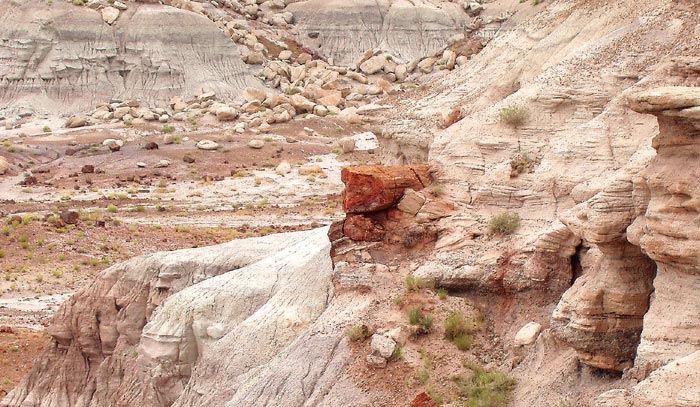
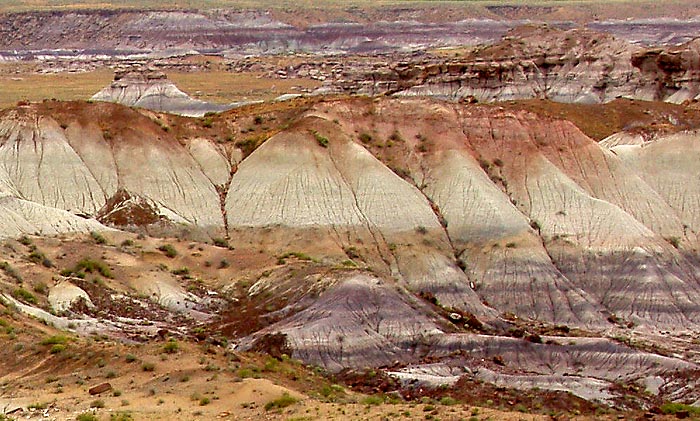
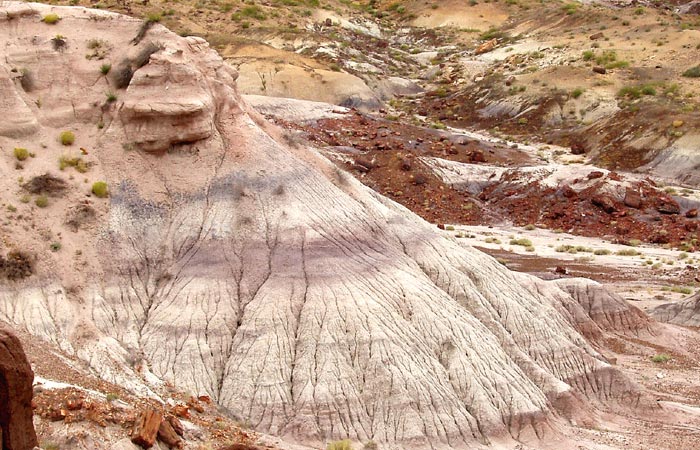
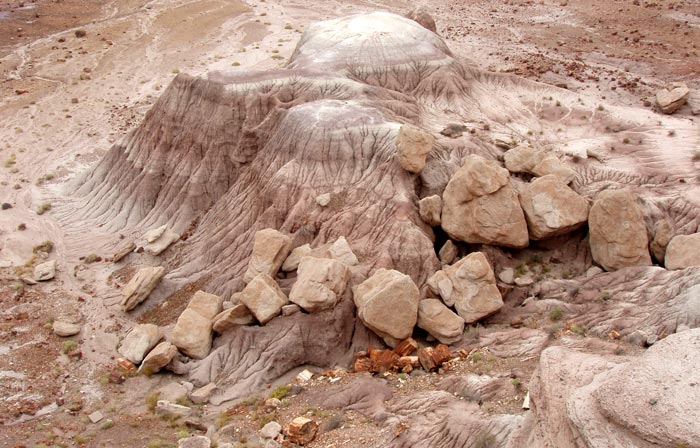
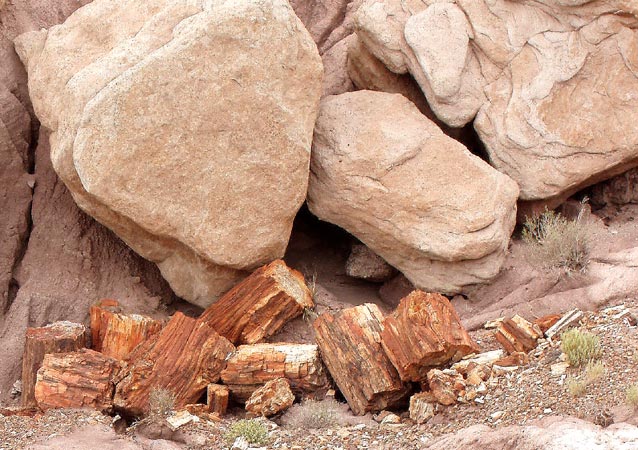
I have a feeling this crow is regularly fed by tourists.
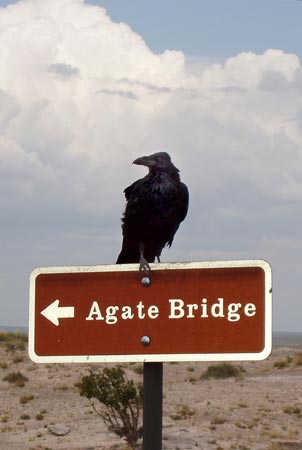
This beautiful slab of petrified wood was right beside the road.
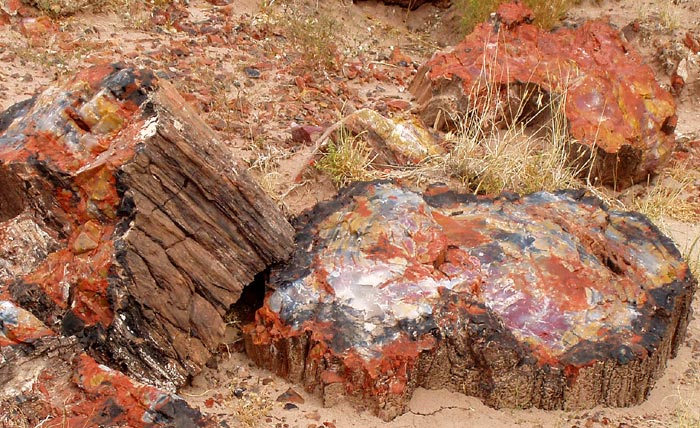
It looks even better when you take time to examine the detail.
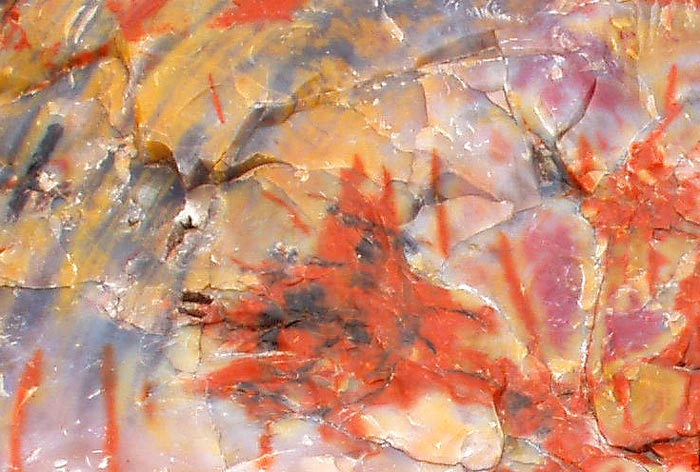
Ace enjoys his colorful perch. Our stay had been under largely overcast conditions but one of our traveling companions came back to the Petrified Forest about ten days later when it was sunny.
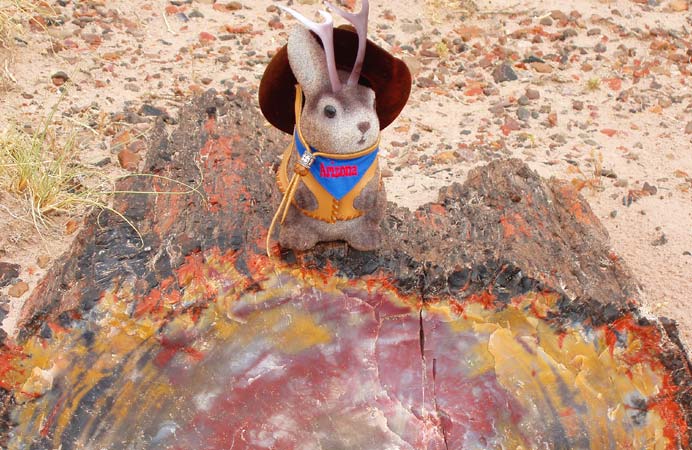
We left the park and headed West; much of the time, it was storming in the distance.
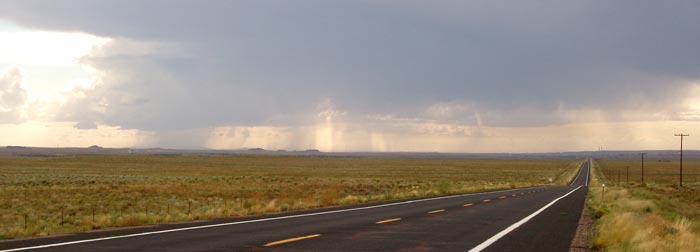
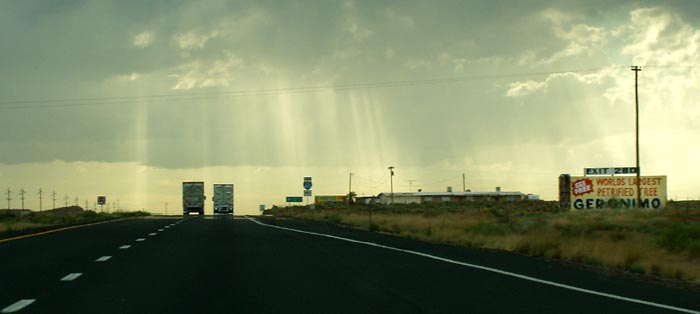
We made a very brief stop at the Jackrabbit Trading Post. Being infatuated with the sinister black rabbit that is it's trademark, I just had to shoot this one on the side of the building. I had pretty much shot every other angle of the place in May.
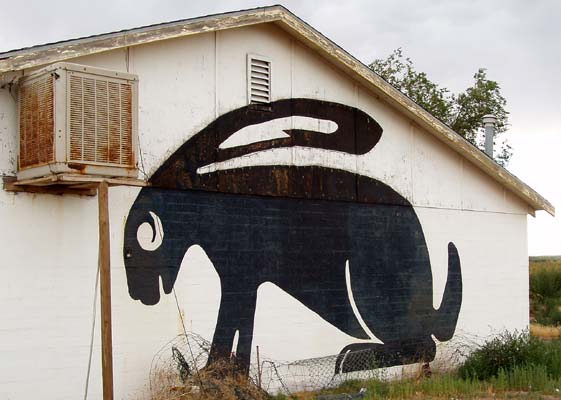
We pulled into Winslow at about 7PM and headed straight to La Posada; I had been there a couple times before but Ace's new entourage members had not, so we had reservations. La Posada was the last of the great Fred Harvey/Santa Fe Railway hotels and restaurants. It was built in 1930 by renowned Southwestern architect, Mary Colter, and is on the Arizona and national registers of historic places.
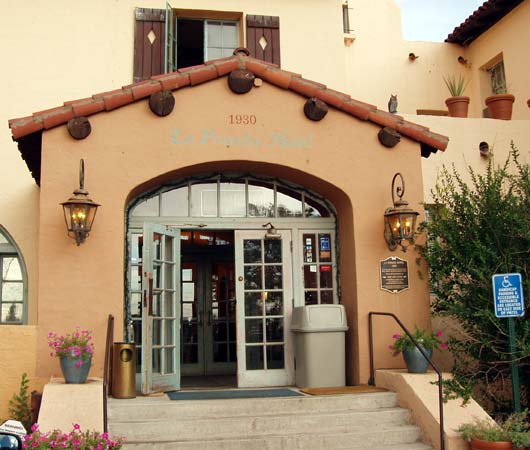
We had two adjoining rooms at $149, total.
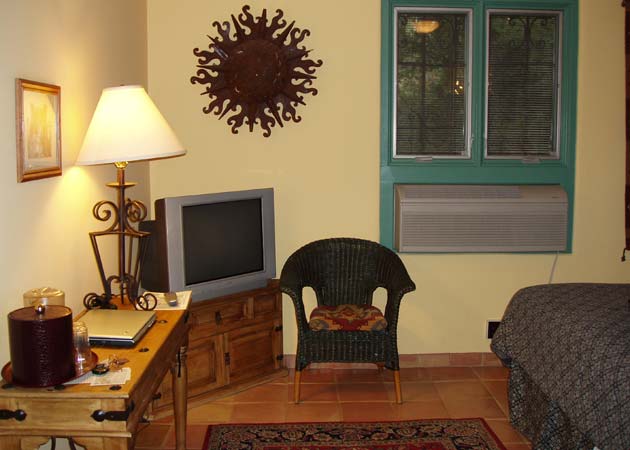
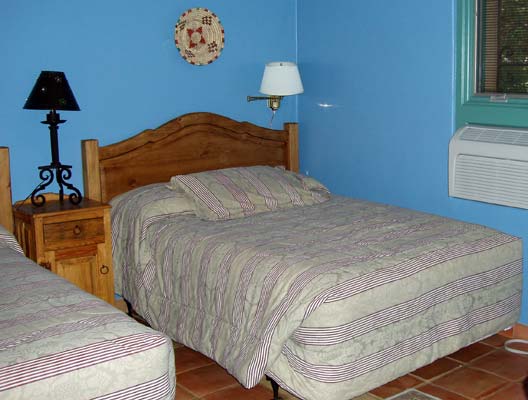
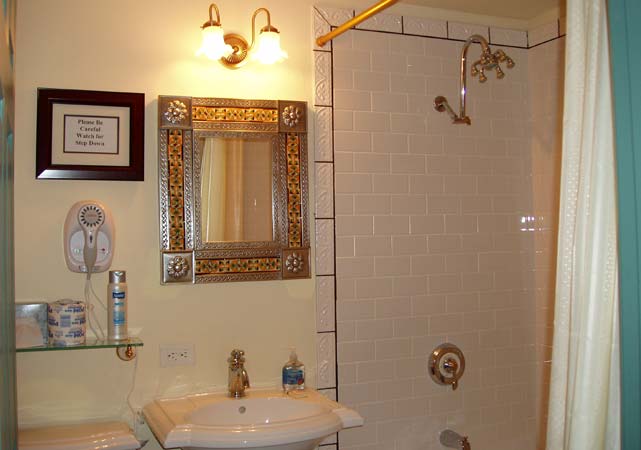
There was a beautiful 1930 plaster topographic map of Arizona displayed in the lobby. back in the heyday of La Posada, it was consulted by tourists who wanted to take a guided "Indian detour." Tours set out in custom Cadillac, Packard or White touring cars and often had a picnic basket from La Posada's kitchen.
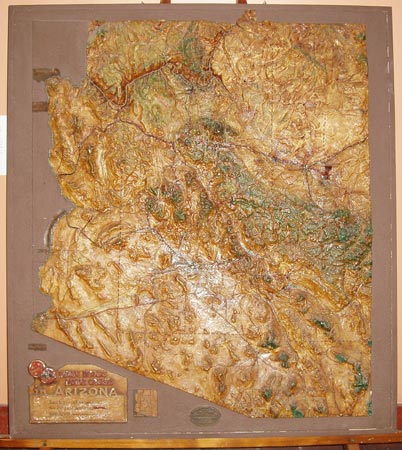
Speaking of La Posada's kitchen, we had arrived in time for dinner. Here's Ace, checking out the array of food.
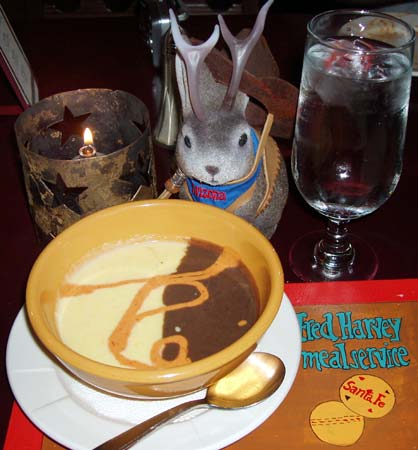
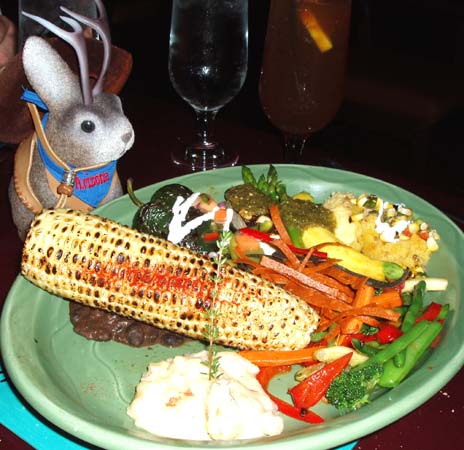
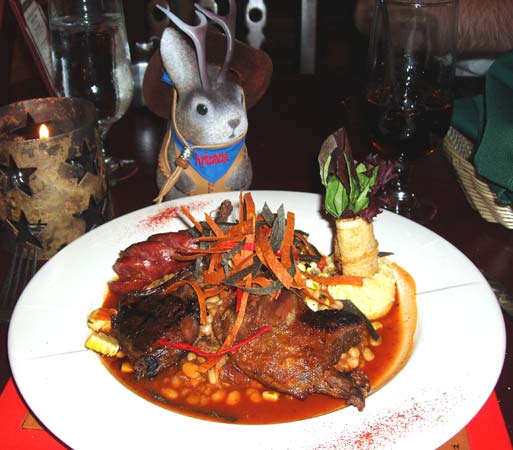
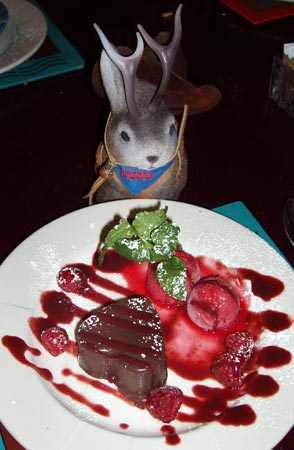
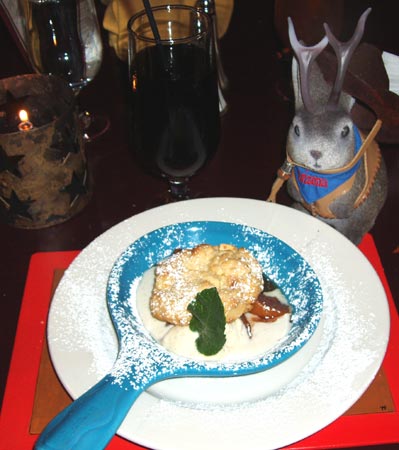
Of course, Harvey Girls are part of the experience.
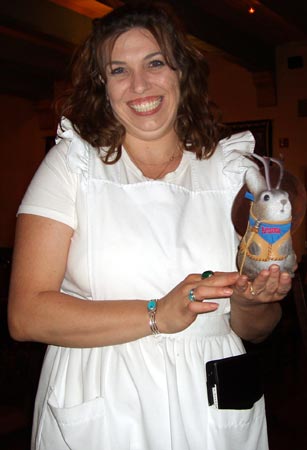
There are few better ways to end a day of adventure than with a kiss from a pretty girl who just brought you food.
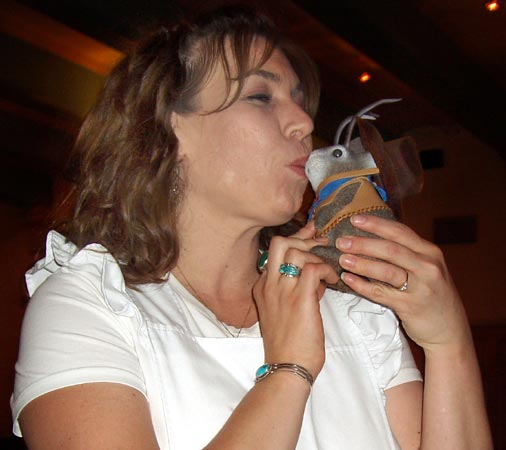

Jackalopes are, after all, Native American.

I doubt the concrete Brontosaurus was part of the original design, but it's in character with Holbrook, which has a few of them around.

These things are beautiful, but I think I like them at night when you can't see the phone poles and such.



The motel turned out to be a good place to watch trains. The view directly South is blocked by another building, but the view is clear to the Southwest...

...as well as to the Southeast. The summer sun leaves the North sides of the trains in shadow by mid-morning. Winter would be a better time for this.

Ace is ready to resume his journey West, but first, if the wigwams look familiar to you but you've never seen them before, you may have seen the Cozy Cone Motel in the Disney/Pixar movie, "Cars."

This sign for the Pow Wow rock shop in Holbrook hints that the shop might have been a motel in a previous life.

New Mexico isn't the only Southwest state to have nicely decorated bridges; this is Interstate 40 at Holbrook.

I've never stopped at the dinosaur park at exit 292, though I'd like to, someday. However, I'm not sure a blurred view of them from a car going 70mph doesn't gloss over some flaws and give them a bit more realism.

"Dust devils" are small tornado-like air vortexes that scoop up a lot of dust. If you look near the top of the picture, as well as at the ground, you can tell this one is quite tall.

I'd not stopped in this tourist trap before. It's just West of the entrance to the Petrified Forest National Park.

Petrified wood, culled from private land around the park, is quite plentiful and cheap in it's raw form.

This sort of fake teepee is common at classic tourist traps in "indian country." Along Rt66/Hwy 40 in this part of Arizona, you can see them at Meteor City, and Geronimo's, in addition to these at the Painted Desert Indian Center. They are all so alike in structure that I wonder if the same person made them. This one features Kokopelli, the hunchback flute player so common in Southwest imagery...more about him when we reach the Painted Desert.

All day long, it seemed to be storming in the West.

The indian boy painted on this one looks suspiciously like an early Santa Fe logo.

We finally reached our main target of the day, the Petrified Forest National Park.





The Burlington Northern/Santa Fe main line runs through the park. About 60 trains a day pass through; the remains of Rt66 run alongside. The track was originally laid by The Atlantic and Pacific Railroad in 1882 and it was the catalyst for the founding of such towns as Holbrook and Winslow. Later, the track became part of the Santa Fe. The Fred Harvey Company, famous for its hotels along the Santa Fe, used to run tours through the Petrified Forest in the 1930's. Tourists would ride through this land in open roofed "Harvey cars."

These are part of the remains of the Puerco Pueblo, which was inhabited between about A.D. 1250 to A.D. 1380. The pueblo had at least 100 rooms surrounding a central plaza. Artifacts found at the site indicate the inhabitants had contact with both the Mogollon/Zuni people of the mountains to the South and the Anasazi/Hopi people of the mesas and canyons to the north.

Raymond Redcorn, an intern from the Kansas City area, was on hand to explain the petroglyphs at the Puerco Pueblo site as well as another site called Newspaper Rock.

Petroglyphs are ancient symbols scratched into a thin patina that forms on rocks when they are exposed to the elements. The patina is called "desert varnish" and it's color is determined by the mineral content of the rock.

Blacker shades are higher in manganese oxides...

...while redder tones are caused by iron oxides.

Newspaper Rock is a huge conglomeration of petroglyphs.


This set of rocks and petroglyphs near Puerco Pueblo is a solstice marker. The mid-summer sunrise would shine through the gap between the rocks at upper left...

...and onto the spiral seen in the left third of this picture.

There is a variety of types of petroglyphs: anthropomorphs (human-like figures)...

...zoomorphs (animal-like figures)...

...katsinas (spiritual figures), hands, tracks and geometrics. This is a set of geometrics with an anthropomorph to the left and three zoomorphs in the middle.

Some of the petroglyphs are pretty hard to see at a distance.


The petroglyphs in the park are thought to be 650 to 2000 years old.

An isolated boulder near Newspaper Rock contains a petroglyph of Kokopelli, the hunchback flute player so common in Southwest imagery.

At least 13 variations of Kokopelli existed in ancient illustrations; some are insect-like and others, more human. He seems to have been popular enough to cross ancient cultural lines and there are variations on his tale, but all versions credit him with fertility of land and women.

Kopopelli has become a much-exploited symbol of Native American culture and I've seen giant metal statues, brightly colored stuffed toys, key chains, coin purses, refrigerator magnets and the coaster Ace is wearing. You name it, if its a tourist trap item, he's there. I've seen him used on "local" souvenirs as far out of his range as Missouri and Mexico.

I think it's a nice touch that the doors to the restrooms at the Puerco Pueblo ruins feature these plexiglass petroglyph panels.

This petrified log has splintered into many thousands of pieces over the years.

Even though the overcast weather dulled the colors, the landscape was worth a few stops.








I have a feeling this crow is regularly fed by tourists.

This beautiful slab of petrified wood was right beside the road.

It looks even better when you take time to examine the detail.

Ace enjoys his colorful perch. Our stay had been under largely overcast conditions but one of our traveling companions came back to the Petrified Forest about ten days later when it was sunny.

We left the park and headed West; much of the time, it was storming in the distance.


We made a very brief stop at the Jackrabbit Trading Post. Being infatuated with the sinister black rabbit that is it's trademark, I just had to shoot this one on the side of the building. I had pretty much shot every other angle of the place in May.

We pulled into Winslow at about 7PM and headed straight to La Posada; I had been there a couple times before but Ace's new entourage members had not, so we had reservations. La Posada was the last of the great Fred Harvey/Santa Fe Railway hotels and restaurants. It was built in 1930 by renowned Southwestern architect, Mary Colter, and is on the Arizona and national registers of historic places.

We had two adjoining rooms at $149, total.



There was a beautiful 1930 plaster topographic map of Arizona displayed in the lobby. back in the heyday of La Posada, it was consulted by tourists who wanted to take a guided "Indian detour." Tours set out in custom Cadillac, Packard or White touring cars and often had a picnic basket from La Posada's kitchen.

Speaking of La Posada's kitchen, we had arrived in time for dinner. Here's Ace, checking out the array of food.





Of course, Harvey Girls are part of the experience.

There are few better ways to end a day of adventure than with a kiss from a pretty girl who just brought you food.


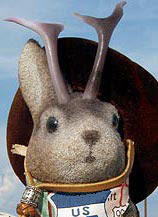
0 Comments:
Post a Comment
<< Home